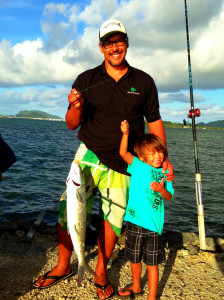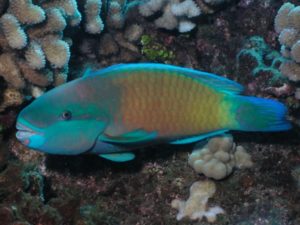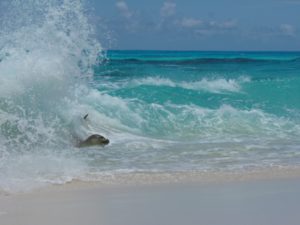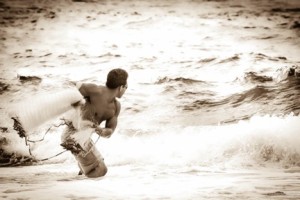We have much more to do and your continued support is needed now more than ever.
Fishing with Aloha

Since ancient times, fishing has always been an integral part of life in Hawai‘i. Informed by local values and generations of knowledge, Hawai‘i’s fishers have traditionally shared a strong passion and deep respect for Kanaloa’s realm – the ocean and all its life and resources.
Today, fishers are all too familiar with modern society’s impact on our marine environment, having witnessed the effects of pollution, invasive species, reef-smothering runoff, and illegal poaching on our once-abundant fisheries.
While Hawaiian monk seal sightings in the main Hawaiian Islands are rare, monk seals and fishers do occasionally interact. Unfortunately, monk seals cannot be expected to have the experience or instinct to avoid such interactions. So it is up to us to do what we can to minimize these interactions. Whether you fish in Hawai‘i as a resident or a visitor, please be sure to follow these steps to help prevent human-seal interactions:
Do Not Feed Monk Seals or Discard Old Bait or Scraps into the Water When Seals Are Around
One might assume that feeding a seal would keep it satisfied and uninterested in fishing gear and bait, but in fact, the opposite is the case. Intentionally feeding seals, or accidentally feeding them by tossing old bait and scraps in the water when a seal is around, increases the likelihood that the seal will come back for more food and persist in the fishing area. Seals that have been fed (intentionally or unintentionally) are more likely to seek out humans because they learn to associate people with free handouts and an easy meal. These seals may approach fishers and other ocean users. Not only can this be an unwanted experience for fishers, but it also increases the seal’s risk of accidental hookings, entanglement, injury and death.

In some cases, seals may steal bait and hooked fish directly off fishing gear, leaving the gear intact while the seal escapes without being hooked or entangled. In other cases, the fishing line snaps and the seal steals the bait or catch with the gear still attached. This increases the seal’s risk of injury or death from ingestion of hooks and lures, or entanglement in line. Taking preventative measures to decrease interactions with seals can be a win-win solution. Minimizing interactions is beneficial to the seals, provides a better long-term fishing experience for fishermen, and will increase the likelihood of preserving fishing gear.
Take a Short Break or Change Locations if a Seal is Encountered While Fishing
Seals are very curious creatures and investigate new objects in their environment. Taking a short break from fishing while a seal is passing through the immediate area may increase the chances that the seal will move through quickly and allow fishing to continue. Fishing success may also be increased by moving away from areas where seals are present.
Reduce Seal Attractants in the Water
When spearfishing or wading, remove fish as quickly as possible from the water and put fish onto a vessel or float, or into a sealed container. Avoid throwing back bycatch species when seals are in the area. Report abandoned nets, which may catch and hold fish that attract seals and pose seal entanglement and safety risks.
Use Barbless Circle Hooks
Barbless circle hooks help minimize post-hooking injuries to seals and can still be used with live bait. Barbless circle hooks have been proven as effective as barbed hooks for catching fish while reducing the severity of injuries to non-target species, including turtles and seals. These hooks give the seal a better chance of quickly ridding itself of the hook without human intervention.
Report Human-Seal Interactions

If a Seal is Hooked:
Never try to reel in a seal that may be hooked. If the hook is set, carefully take in any slack line and then cut the line as close to the seal as safely possible. If the hook is not visible in or around the seal’s mouth or throat, there is a possibility that the hook has been ingested, and pulling on the line may cause serious injury or death. If the hook is not set, put slack on the line and give the seal time to release itself.
If a Seal is Entangled:
For your safety and the seal’s protection, never try to disentangle a seal or other marine mammal. Call the hotline number provided below to report the entanglement immediately and to mobilize assistance. Most monk seals are not aggressive toward humans, unless they feel threatened. However, seals that have been previously fed (intentionally or unintentionally) and have learned to associate humans with food can sometimes appear aggressive when they go after fish or bait in the water. This can be of particular concern for spearfishers with fish on stringers in areas where seals have been previously fed.

If you see an injured seal or need to report a human-seal interaction that may have harmed a seal, please call the marine mammal hotline as soon as possible:
(888) 256-9840 (24-hour toll-free hotline).
Calls may be made anonymously. Your call could save a seal’s life!
Please Report All Seal Sightings!
Your kōkua is also needed to help resource managers understand the seals’ habitat and accommodate fishing traditions and fishing areas.
O‘ahu: (808) 220-7802 || Kaua‘i: (808) 651-7668 || Moloka‘i: (808) 553-5555
Maui and Lāna‘i: (808) 292-2372 || East Hawai‘i (808) 756-5961 || West Hawai‘i: (808) 987-0765
For more information on reporting seal interactions, contact NOAA or DLNR Division of Aquatic Resources: NOAA Fisheries Service, Pacific Islands Regional Office, (808) 725-5000 / pirohonolulu@noaa.gov / www.fpir.noaa.gov
Department of Land and Natural Resources, Division of Aquatic Resources (808) 587-0400 / dlnr@hawaii.gov / http://dlnr.hawaii.gov





















